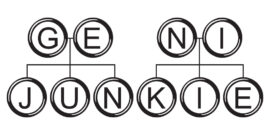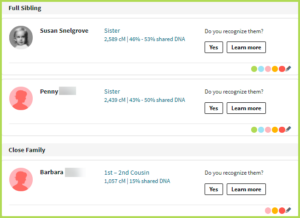OK, so you’re finally ready to build your family tree! Sorry it took me several Blog posts to get to the good stuff! Let’s go!
If you have decided to not subscribe to a family tree provider service, and have chosen your own software, you can still build your tree using information you find for free. In addition to those tips I gave in my earlier Blog about where you can find archival material, the single best, and remarkably free repository of genealogy information is FamilySearch.org. This is a site provided by the Church of the Latter Day Saints in Salt Lake City, Utah.

The information they have published covers the globe, and the amount of records is mind blowing! They have also introduced a tree building program of their own, similar to what you’d find on a paid site. A lot of the paid sites even link to record sets that have been provided by FamilySearch. So believe me, you can go an awfully long way with your research just using this free site. What FamilySearch.org is all about is a much larger topic than I can get into here, so it will be the subject of a future Blog post.
If you have decided to use a paid provider, that’s awesome! The discussion below will outline some very useful general information about starting your tree. The topic of how to research successfully on one of these sites is simply too massive to delve into here. So watch out for many future Blog posts with all the tips and tricks you need to know.
I am going to use Ancestry as an illustration for this general discussion, since it’s probably the most popular site and the one I am most familiar with. But all providers will be similar. So every time you see me say “Ancestry” below, you can insert your own service provider name.
The first thing you are obviously going to do is sign up (and pay), and it’s going to ask you to set up your user name. I highly recommend that you use one that doesn’t identify you personally, for security purposes that I will explain later. For instance, I am “gratescove”. There’s a spot for you to include your surnames of interest, how long you have been researching, etc., and this is definitely useful to include because it does help people collaborate with you later. You’ll be prompted for other personal details which you may choose to provide or ignore, like your general age and where you live.
Public versus Private Family Trees
You are going to be prompted whether you want the tree to be Public or Private. This is a very important consideration, and there are many pros and cons to each. I wrote many paragraphs on this topic! So much so, in the end I decided this would make a better separate Blog Post on its own. If you would like to take a side trip now, you can jump to “Should Your Family Tree Be Public or Private?” But if you want instant gratification, I’ll tell you my personal preference. I like making a tree Public, because I think you miss out on many collaboration opportunities with Private Trees. That said, some people really value their privacy, and it is certainly okay to go that route.
And now, the moment you have been waiting for has finally arrived…..
Making Your First Family Tree Entry!

Once you have named your tree and dealt with these settings, to build a new family tree is really quite simple. You just start with yourself and your parents, and the program does the rest. It is going to give you those “green leafs” (as seen on TV) as hints. When you click on them, it takes you to suggested records which you can reject or accept. If you accept, it automatically attaches the record to that person’s profile, and populates the data (such as birth date, marriage date, death or even parents or children) straight into your tree. Boom! If it was a suggested set of parents, you just added the next generation to your tree.
Next Steps … Researching The Records

And rather than relying on the hints alone, you will start actively looking for your ancestors in the search features for the website. Of course you start filling in details for your parents, and then on to your grandparents and so on. You might find them on Voters Lists or Census records, or their death, marriage or birth records. From these last two, you will learn things like a woman’s maiden name, parents’ names and places of birth, occupation, witnesses (who might be siblings), etc. And here’s a great tip – obituaries can be Genealogical Gold! Your provider might have some of these records, but a quick google search might help you find one since lots of funeral homes provide these archives on their own websites.
And once you start learning these facts about a person, it naturally leads you to the next generation. Once you fill in new information manually, or accept a hint, the program reaches out and makes even more suggestions for you, including searching other members’ family trees. It doesn’t take too long before you might go back 1, 2 or even 3 generations in your beautifully budding tree.
Don’t Make these Genealogy Rookie Mistakes:
1. It’s Good to Go on a Sidetrip

Here’s one important tip, something that many people commonly do wrong. Don’t just put in your direct ancestors and go straight up. You also want to build your family tree sideways.
So, record all your siblings, your aunts, uncles, and all your grandparents’ siblings, and so on. Trust me, you will find that this will be invaluable later, and well worth the time it takes.
Here’s just one example. Some U.S. states have excellent death records, and others, not so much. You might find Nana Skywalker lived in a state that doesn’t have on-line death records. Or even if they do, it might not show Nana’s parents’ names on the record.
However, Nana’s sister Princess Leia may have lived in another state (or galaxy, far, far away) that does have excellent death records. If you find Leia’s death record, and it does record her parents, congratulations, you have just added a generation! And even better, you now have a new maiden name (Amadala), so you can start working on the next generation!
You wouldn’t have found that important detail, had you not taken the time to record Luke and Leia. You can make the same kind of discoveries with censuses, immigration records, and passenger lists. While you might not find a record for your relative, but if you find his brother, sister, aunt or uncle, who knows what you can learn!
On a side note, I was highly amused that when I was making the sample tree for Pat Fakefellow on Ancestry… It popped up with hint leafs for the Skywalker family! It even suggested a potential mother for Padme – Shmi Skywalker of Massachusetts. Now that’s impressive, Ancestry!
2. Don’t Believe Everything You See
This is probably one of my worst pet peeves about other people’s trees. Time and again I see people in family trees that I know are 100% wrong. As convenient as those green hints are, they are also one of the culprits for poor tree building. Why? Because the hints are also generated by searching other people’s trees. And let’s face it, not many people are as good a genealogist as you are going to be. Many people see the green leaf suggesting a name, and with a very quick look (or none at all), they click . Presto! They just added the wrong person to their tree.
And then what happens? The next person researching that name does the same thing. And over and over and over. And soon, there are 35 Family Tree owners who have the wrong person in their tree. People see a name in another tree, particularly if it has a lot of people in it, and they think, “gee, this must be true”. Click! Argh!!
Never, never, never(!) just click on a suggested person and accept them into your tree, unless you take the time to search all the records and corroborate that the suggestion is in fact correct. What is the point of building your Family Tree if you don’t have the right ancestors recorded? You can have a great tree and build lots of wonderful and compelling stories around the people. Only problem is, they’re not YOUR people.
3. For Heaven’s Sake, Don’t Guess
Often times you will come across multiple people in the records that could potentially be your ancestor. Particularly if you are looking at a common name like John Brown. I know it can be really frustrating, because you SO want to be able to fill in that name in your tree. All I can say is investigate the records as much as possible, and find other information that might help you come to an educated guess.
4. But if you DO Guess, Document your Conclusion
If you do feel the strong urge to fill in that name, there are note pages where you can outline all your reasoning why you chose that person. Maybe you found a couple of records that mentions a third person who somehow connects your targeted person to your family. There can be many clues that all add up to one particular choice. Write it down. One day you might find something else that changes your mind, and you want to be able to easily remember why you chose who you did.
So please be careful. If you are going to spend all kinds of time building your tree so that you can leave a wonderful legacy for your own kids, make sure you get it right!
Why is my Ancestor So Difficult to Find?
So you have started filling in your tree, and are making some progress by clicking on good hints and searching manually in the records. But all of a sudden you run into a problem… You draw a blank on a person. Uh oh! This is going to happen to you sooner or later. So here are some suggestions to help you find those ancestors that are proving elusive.
Suggestion # 1 – I can tell you that searching more recent people is harder than older generations. Again for privacy reasons, the information is only available for time periods when a living person is now likely deceased. So for instance, census records are usually published only after 100 years have passed. So it can be a little tricky sometimes to find a person born say after the 1940’s, but don’t worry, there is almost always a way to find something on an ancestor. Voter’s Lists and High School Year Books, Newspapers and Obituaries are just a few suggestions to help broaden your search. I’ll have in depth discussions of how to broaden your searches for people in my future Blog Posts.

Suggestion # 2 – If you are having a hard time, this could be because of a name change. Some European or Asian immigrants for instance anglicize or shorten their names when they emigrate. So if you come up empty, you will have to broaden your mind and search terms to include wildcards and name variations when doing your searches. First names can be tricky too, because it’s not unusual for a person to use their middle name rather than their first in records.
Or sometimes they just make a new name up! Sometimes the name change happens with our ancestors who have a dark and questionable past. Pat Fakefellow is going to have a hard time searching for his great grandfather Anakin Skywalker! Once the dark side of the force took over, Anakin became Darth Vader. Heck, even Luke didn’t know he was his father! And then there’s the big issue of name changes for adoptees like Aunt Princess Leia Organa. The audience knows she’s Luke’s twin, and really a Skywalker. Ok, enough silliness, you get the point!
Suggestion # 3 – There could also be a record indexing problem at the website. Human beings are transcribing these records, and the handwriting on the records can be awful. Human beings make mistakes, and if the person transcribing this particular index record simply goofed, your ancestor might be accidentally missed by the search engine. Luckily, Ancestry gives you the opportunity to also browse through the original records page by page. This can be time consuming obviously, but more than once I have found an ancestor doing it this way when they didn’t appear in the search engine results. So take the time to dig deeper, just to be sure.
Suggestion # 4 – You are going to have to become a History major! Depending on when your ancestor lived, the geopolitical issues of the time influenced their lives and specifically “where” they lived. Think of the history of Europe for instance. Even in just the last 150 years there have been two world wars and many other regional conflicts and rulers/politicians that have come in and out of power. This has changed many country borders countless times. Depending on the year, they might be listed as living in “Austria” when in fact they lived in Poland. You are going to want to learn the history and timing of the Austro-Hungarian Empire and “Prussia”. And let’s not even start on Asia! Or even the US, before states became states. Just keep in mind that when you are searching for someone, don’t think of a place name using your 21st century perspective. Cast your mind back to what the place was called when your relative actually lived there.
It’s Time to Let you Fly on Your Own
Once you get back a generation or two, it becomes easier to find people. So as I stressed before, make very sure you have those first two generations solidly built, because you want to make sure you are starting your journey off error free.
As you might imagine, there will now be simply tons of information available to you, and you have to get familiar with the site you’re using. What type of information do they have? From where? How do you look for it? How should you record it? Are you looking at the right ancestor? Should you say yes or no to those “hints”?
There is so much specific information I can share on how to search successfully, but it is too much for one Blog post. So, I will give you this knowledge through a series of Blog posts to follow, so you can learn how to do a great job at it. Anybody can slap together a lame tree using the hints. You want to be meticulous about your research, because if you are going to the trouble to do all of this, you want it to be right! Right?! This is the beginning of a beautiful Genealogist.
I hope you found some useful gems in this series of introductory Posts, so now you can start building your family tree with confidence. If you’d like to take that side trip now to see the discussion on “:Should Your Family Tree be Public or Private?”, here is the link.
Your Geni Junkie friend,
Susan








